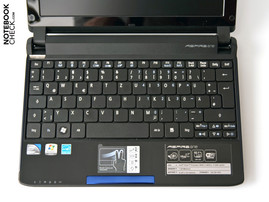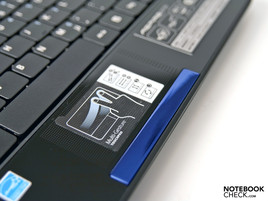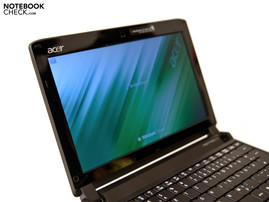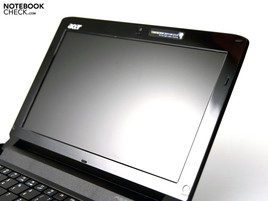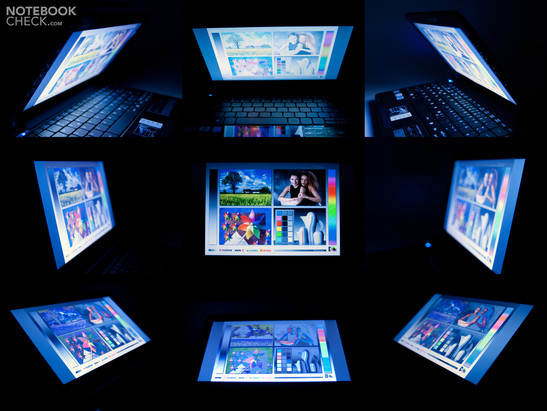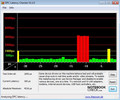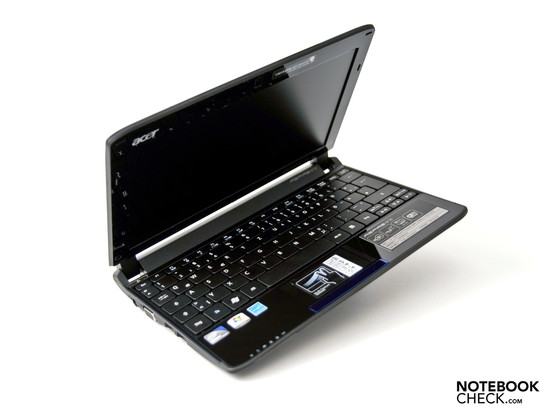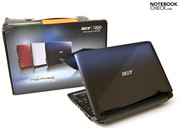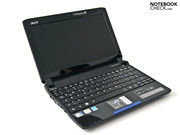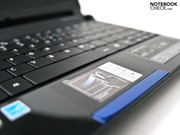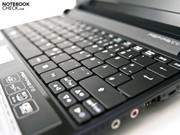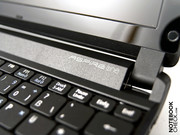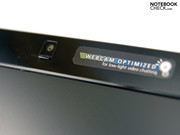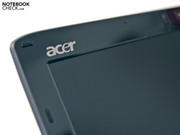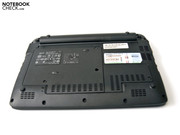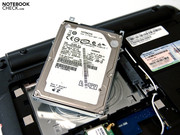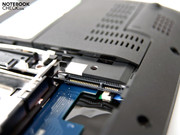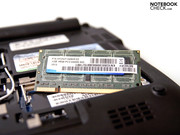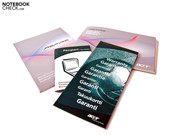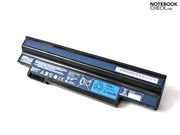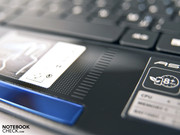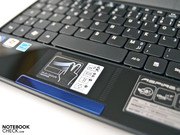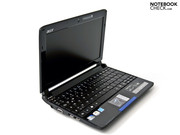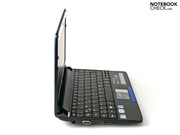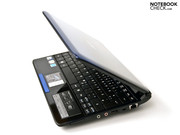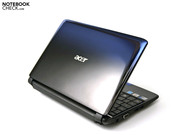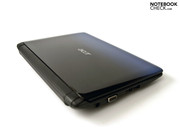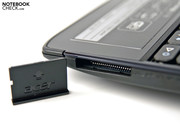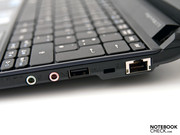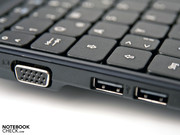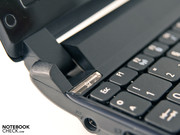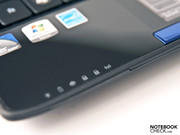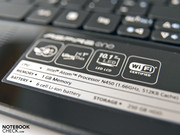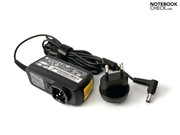Review Acer Aspire One 532 Netbook
The „One" and Only?
Aspire One 532, the newest netbook from Acer, is equipped wtih a 10.1 inch display and a LED backlight. The 532 is Acer's first netbook running on Intels new Pine Trail platform. The netbook is also equipped with an Intel Atom N450 processor (1.66 GHz) and an integrated GMA 3150 graphics chip. Additionally, the Aspire One 532 is also the successor to the highly successful Acer Aspire One 531 and so we have no doubt that it is packed with a great many useful features which we will look at in further detail in our review.
The Acer Aspire One 532 netbook is available in three different colours: blue, white and red. However, looks are not all that this netbook has. As previously mentioned, the 532 operates an Intel Atom N450 processor with an integrated GMA 3150 graphics chip, which uses significantly less power and thus allows for a longer battery life than the older Atom platform. Additionally, the netbook also uses 1 GB of DDR2 RAM and a 250 GB HDD (Hard Disk Drive).
For a few more euros, the user can equip the netbook with a 10.1 inch screen with a native resolution of 1280x720 pixels (HD-ready display) and a Bluetooth module. The "smaller" model with the native resolution of 1024 x 600 pixels is available with both a matt or glossy display.
The new models are delivered with Windows 7 Starter preinstalled. The recommended retail price from Acer for the "smaller" version of the 532 is 333 euros and 349 euros for the "bigger" model with a higher native resolution and integrated Bluetooth.
Case
The display makes a good impression at a first glance. The stylish screen cover, which has a beautiful pattern of dark blue fading to black, is especially pleasing. The netbook is also available in ruby-red or white. Thankfully the bar which covers the buttons for the mouse is also the same colour as the netbook. However, sadly Acer does not offer a black version of the netbook.
The lacquering of the 532 is very well done, but the shiny coating of the display cover can easily accumulate scratches and fingerprints. The workmanship of the netbook is of a high quality and we could not find any faults in it. The whole case is made of a synthetic material and due to the lacquer and the workmanship it has a very nice appeal.
The case is very sturdy. It distorts very little when pressed upon with the hand. Only when one puts a lot of pressure does the case give way. The keyboard is a matter of taste. The individual keys are not properly screwed in and are thus a bit wobbly. The synthetic material used for the keyboard feels cheap and not of very good quality.
The two display hinges are firmly bound to the case and do a good job of holding the screen up.
The Acer Aspire One 532 weighs 1.22 kilograms with the battery put in. Overall, that is a good value for a 10.1 inch netbook which measures 25.9 x 18.5 x 2.5 centimetres (B x L x T). The power supply delivered with the 532 weighs 180 gramms.
Connectivity
Connectivity
There are no special ports on the Aspire One 532 and one must satisfy him/herself with the usual ports found on netbooks.
On the left side of the netbook, there are two USB ports, an analogue video output (VGA) and the power outlet. Sadly, the positioning of the USB ports makes them rather hard to access, and one must use a bit of force to put in, for example, a USB stick. The integrated Intel GMA 3150 graphics chip restricts the resolution for external monitors connected to the netbook via the VGA port to 1400 x 1050 pixels. This resolution can be rather restrictive when using bigger monitors or TVs.
The right side has two more USB ports, the audio and microphone ports, a Gigabit RJ-45 LAN port (Atheros AR8132 PCI-E Fast Ethernet), a Kensington lock and a Multi-in-1 cardreader (SD (SDHC), xD, MMC, Memory Stick Pro (Duo)).
As the case is very thin near the front there are no ports in the front. Only two stereo loudspeakers are placed there. The back side is similarly free of ports as the big 6 cell battery with 63 Wh capacity takes up all the space there.
The 532 also has an Atheros AR8132 PCI-E Fast Ethernet LAN module and an integrated WLAN module installed. The Atheros AR5B95 chip supports WLAN with 802.11b/g/n. Bluetooth is only available in the slightly more expensive version with the HD-ready screen (1280 x 720 pixels) which costs around 349 euros.
The available ports are not unusual for netbooks. However, the multi-in-1 card reader is a pleasing feature which allows for a variety of cards to be read by the netbook. However, the hard-to-access USB ports are not so nice as they require the use of force and the Kensington lock is not placed well either.
Installed Software
Acer delivers the 532 netbooks with Windows 7 Starter (32-Bit) preinstalled, which should enable the netbook to efficiently use system resources and work faster. Additional software is also delivered alongside the Windows 7 OS. For example: Adobe Reader 9, Adobe Flash Player 10, eSobi, Microsoft Office Personal 2007, McAfee Internet Security Suite (60-day trial) and a few other programs from Acer itself.
Delivery Contents and Optional Accessories
The package in which the netbook is delivered only includes the most necessary things. The package includes a fitting power adapter, a guarantee card, an extensive user manual, and a quick start guide. The software for a system backup is not already installed on the netbook, and so the user must create a recovery medium of his own with the software delivered alongside the netbook. The power adapter is very practical as it can be equipped with various plugs so that the user can use it in different countries. However, this is not a free feature and the user will have to pay extra to get it.
The optional accessories are extensive in range. Acer offers a protective cover for the netbook (19.90 euros), an additional battery (99 euros), a power adapter (39.90 euros), an external hard disk (99 - 149 euros), an external USB-DVD optical drive (79 euros) and an extension of the guarantee on the netbook to 2 or 3 years, for 35 or 55 euros. However, Acer does not offer a Broadcom HD-Decoder which allows for better playback of HD videos even though the netbook still has a free mini PCI-Express slot.
Input Devices
Keyboard
The keyboard leaves us torn between two opposite opinions. The keys have a comfortable stroke distance and the slightly rough surface of the keyboard offers a good feel. The keys are 16 x 16 millimeters in size. Due to the standardized layout of the keyboard, the user can use touch type easily. However, the thin and wobbly (due to the loose screwing in of the keys) design of the keys is a very annoying feature of the 532. The synthetic material used for the keys seems very thin and cheap when compared to the material of which the case is made. The Fn combinations are coloured a stylish light-blue so as to be easily perceivable, and can be activated via a Fn key on the bottom-left side of the keyboard.
Touchpad
The touchpad is positioned directly under the keyboard. The touchpad has a separate vertical scrolling bar on the right side, despite a big diagonal of 7.3 centimetres. The knobbly surface is very useful as it is not too rough and thus allows for precise and simply navigation. A great feature of the touchpad is the multi-touch gestures (scrolling, rotating, changing the page and zooming) due to which the use of the netbook without an external mouse is much simpler. The touchpad can be configured in many different ways. The mouse keys are hidden under a stylish blue bar in our test model. They offer a good pressure point and the clicking noise is not too loud.
Display
Our test model of the Acer Aspire One 532 netbook is equipped with a matt 10.1 inch screen with a native resolution of 1024 x 600 pixels. Acer also offers a glossy display for the netbook and for 16 euros more one can order the 10.1 inch HD-ready screen with a native resolution of 1280 x 720 pixels.
The screen offers a good brightness level despite the matt surface. In the right area of the screen the brightness can reach up to 241 cd/m² and the average overall brightness of the display lies at 216 cd/m². The screen also has an illumination level of 82% which is good. The colours and the picture quality are also clear.
The colour black is slightly greyish due to a high black value of 1.48 cd/m², and so, sadly, the netbook does not offer a satisfying black, and because of the black value the contrast is very low despite the high brightness. The netbook has a maximum contrast of 163:1 in the lower region of the 10.1 inch screen. The 532 also has a 0.3 megapixel integrated webcam, which offers a picture resolution of 640x480 pixels, for video calls. There is also an integrated microphone next to the camera for voice recording and transmission.
All-in-all, the 10.1 inch display of the laptop with LED backlight left us with a positive impression. The only things we can criticize about the screen are the high black value and the thereby resulting low contrast. The native resolution of 1024 x 600 pixels may restrict the users overview of the desktop and so it is recommended that the user pay the extra 16 euros to get the HD-ready display, which has a higher resolution, and can thus display the full width of most internet sites. This will make it easier for the user to surf on the internet as s/he will not have to scroll so much.
| |||||||||||||||||||||||||
Brightness Distribution: 82 %
Contrast: 158:1 (Black: 1.48 cd/m²)
Performance
We have tested many other netbooks running on the new Intel Pine Trail platform and, after having compared the results with other netbooks which run on the older Intel platform, we came to the conclusion that there is no major increase in performance. The 45 nanometer structure of the Intel Atom N450 processor runs at a clock frequency of 1.66 GHz. However, the processor now supports both the memory controller and the graphics engine (Intel GMA 3150), due to which the power consumption has fallen by 4.3 watts.
The netbook is also equipped with 1 GB of DDR2-667 RAM from Hynix and a 250 GB S-ATA-HDD from Hitachi which runs at 5400 rpm (rotations per minute). The RAM can be upgraded up to a maximum of 2 GB as there is only one RAM slot in the netbook.
We ran a variety of benchmarks on the Aspire One 532 to see how it performed in comparison to other systems. We ran all the benchmarks with the netbook in the high performance profile of Windows 7 and with the energy saving option deactivated. The processor runs at a speed of 1.66 GHz during this mode.
The Pine Trail platform does not perform much better than older platform in the performance benchmark. The Intel Atom N450 reached 525 points in single-core and 865 points in multi-core rendering in the CineBench R10. The netbook also scored 1325 points in the PCMark 2005. The Acer Aspire One 532 does not perform much better when compared to the older netbooks, and as we conducted further benchmarks we found that the results became progressively smaller until there was no perceivable difference at all between the older and the current Intel platforms.
| PCMark 05 Standard | 1325 points | |
Help | ||
The Aspire One 532 netbook is not designed for games. This is clearly noticeable in the synthetic game benchmarks. The 532 reached a mere 2761 points in the 3DMark 2001SE! and the results in the other, newer versions of the 3DMark benchmark series fell progressively lower towards 0. For example, in the 3DMark 2006 the netbook scored a pathetic 144 points (CPU: 493 points). Systems with integrated Nvidia GeForce 9400M graphics (ION) offer a much better performance in this area.
Even the results in the WPrime, SuperPI and SiSoftware Sandra benchmarks are low and show no real increase in performance when compared to older systems which ran with the Intel Atom N280 processor. The 1M-calculation from SuperPI required 92 seconds (32M: 4256 seconds) and the 32M-calculation from WPrime lasted 117 seconds (1024M: 3252 seconds). The Intel Atom N450 in our test model can reach 4200 MIPS (Million Instructions Per Second) and 3506 MFLOPS (MegaFLOPS) in the SiSoftware Sandra benchmark.
| 3DMark 2001SE Standard | 2761 points | |
| 3DMark 03 Standard | 718 points | |
| 3DMark 05 Standard | 301 points | |
| 3DMark 06 Standard Score | 144 points | |
Help | ||
Acer uses the 250 GB big Hitachi HTS545025B9A300 SATA-HDD (hard disk drive) for the 532. The result we got from the benchmark of HD Tune Pro 4.01 showed us that the hard disk can perform well. The data transfer rate lies between 32.4 and 84.3 MBs per second. On average the data transfer rate lies around 62.8 MB. The access time is about 21.3 milliseconds and the data transfer rate is a high 161.5 MBs.
Last but not least, we checked the latency times while running Windows 7. For this we used a small tool named the DPC Latency Checker, which displays the latency times graphically. If these times are too high this will lead to problems when peripheral devices are connected to the netbook. The most common problem is the faulty sound delivered by an external sound card. The values of the latency times were mostly fine for the Aspire One 532, but there were a few aberrations, above 1000 µs, which kept popping up repeatedly. This could theoretically lead to problems when the netbook is connected to peripheral devices.
The new Intel Atom N450 with the integrated GMA 3150 graphics in the Acer Aspire One 532 does not offer enough performance power for HD-playback and current games, and is thus not suitable for either of those. The playback of HD videos is not possible with the "smaller" version of the 532. However, the free mini PCI-Express slot next to the hard disk can be a great help in this case. A HD-decoder could be built into this slot and this decoder(for example, Broadcom Crystal) costs around 50 to 80 euros in shops depending on the seller.
Further details for the playback of HD videos and the gaming performance of the new Intel Pine Trail platform can be found in our in-depth test report of the Asus Eee PC 1005PE.
Emissions
System Noise
The noise emission of the small cooler fan lies well within bounds. During normal use of the netbook, the fan causes 28.7 to 32.6 dB(A) and this makes the netbook barely audible. The in-built hard disk drive turns at 5400 rotations per minute and can emit up to 32.8 dB(A) when it is being accessed for a data file. These are well within the usual norms of netbook hardware. When the CPU is under heavy usage, the noise emission can rise up to 33.6 dB(A), however the cooler fan quickly gets the temperature back under control and reduces the noise output.
Noise Level
| Idle |
| 28.7 / 32.6 / 32.6 dB(A) |
| HDD |
| 32.8 dB(A) |
| Load |
| 33.6 / 33.6 dB(A) |
 | ||
30 dB silent 40 dB(A) audible 50 dB(A) loud |
||
min: | ||
Temperature
The surface temperature values of the netbook which we determined are acceptable (room temperature in our test lab lies at 22.5 degrees Celsius). During normal use and with all the energy saving options turned on, the netbook can heat up to a maximum of 35.4 degrees Celsius on the bottom side near the region of the fan. The temperature at the top of the netbook and in the hand-rest regions was negligible.
During heavy CPU usage, the temperature of the netbook case in the hand-rest regions can rise up to a maximum of 36.4 degrees celsius, which is slightly high but not too much. The temperature at the bottom of the netbook and in the area of the cooler fan can rise up to a hot 48.7 degrees celsius. This maximum value resulted only in our practical test but it is still a bit too high.
(+) The maximum temperature on the upper side is 37.1 °C / 99 F, compared to the average of 33.1 °C / 92 F, ranging from 21.6 to 53.2 °C for the class Netbook.
(-) The bottom heats up to a maximum of 48.7 °C / 120 F, compared to the average of 36.6 °C / 98 F
(+) In idle usage, the average temperature for the upper side is 29 °C / 84 F, compared to the device average of 29.8 °C / 86 F.
(±) The palmrests and touchpad can get very hot to the touch with a maximum of 36.4 °C / 97.5 F.
(-) The average temperature of the palmrest area of similar devices was 29.3 °C / 84.7 F (-7.1 °C / -12.8 F).
Loudspeakers
The Aspire One 532 has two, small stereo loudspeakers installed in the front of the case for audio output. These speakers are not much different from the various other disappointing integrated speakers of other netbooks. They reach a very high volume level with very dominant high tones. The low tones and the bass are virtually non-existent. Due to this the sound quality is rather tinny and synthetic. However, the 3.5mm audio ports deliver very good sound quality and it is recommended that the user uses headphones or external speakers.
Battery Life
The Intel Atom N450 processor and the NM10 chipset consume 4.3 W less than the older Atom N280 with the Intel 945GSE und GMA 950 graphics chip. This reduction in power consumption is especially noticeable in the battery life.
We used the "Battery Eater" test to find out the battery life of the Acer Aspire One 532. The "Classic Test" allows us to determine the minimum amount of time the battery will last. For this test, we activated the WLAN and the high performance profile and increased the screen brightness to maximum. After 6 hours and 3 minutes the battery was finally empty and the netbook could not be switched on again.
The laptop can last up to 10 hours and 27 minutes when the user is only using the WLAN and has the display set at a mediocre brightness level with a balanced performance profile. This scenario represents the typical, everyday usage of the netbook. We ran the "Readers Test" from Battery Eater to determine the maximum possible battery life. The battery was finally empty after a very good 13 hours and 52 minutes. The Acer Aspire One 532 performed very well in battery life for a netbook using the Pine Trail platform.
The power consumption stays low thanks to the theoretical difference in power consumption of 4.3 W in comparison to older systems. In normal use, the Aspire One 532 can use up to 4.5 - 7.5 W. When under heavy CPU usage, the netbook can use between 10.3 to 12.6 W. These values are not unusual for Intels newest Pine Trail platform. When the netbook is switched off, the power consumption lies at 0.0 W.
| Off / Standby | |
| Idle | |
| Load |
|
Verdict
The Acer Aspire One 532 netbook leaves us with an overall good impression.
The high battery life is probably the best feature of the new Intel Pine Trail platform. The ports available on the 532 are not unusual for a netbook and one can easily find the typical ports. However, the USB ports are hard to access and the Kensington lock is disadvantageously placed. There is no significant increase in performance when this netbook's values are compared to the older netbooks running on the older version of the platform, but the low power consumption is a big plus point.
The case design is stylish and the display cover has also has a stylish colour combination. The surface is elegant but also very easy to scratch and to leave fingerprints on. The keyboard is a matter of taste but the thin synthetic material is not very great and seems cheap.
Our test model was equipped with a 10.1 inch matt screen and this display delivered good values and a good picture quality. However, the black value is too high and due to that the contrast is not very good.
In conclusion: the Acer Aspire One 532 is a good, well-designed netbook with various features and strengths but also a few weaknesses. A big advantage is the model variety offered by Acer. The netbook is available in three different colours and with three different screen types (something which is unusual for netbooks). Both models are available in shops and cost around 333 euros (Display: 1024 x 600 pixels, glossy or matt, without Bluetooth) and 349 euros (Display: 1280 x 720 pixels, glossy, and integrated Bluetooth).
Update: Acer has just introduced the Aspire 532G with a dedicated NVidia GPU aka ION (2) at the MWC. Thus, the 532G should have a significantly higher gaming performance and better (flash) HD video playback. Thanks to NVidias Optimus the battery life will not suffer when the graphics usage is not high.


 Deutsch
Deutsch English
English Español
Español Français
Français Italiano
Italiano Nederlands
Nederlands Polski
Polski Português
Português Русский
Русский Türkçe
Türkçe Svenska
Svenska Chinese
Chinese Magyar
Magyar




